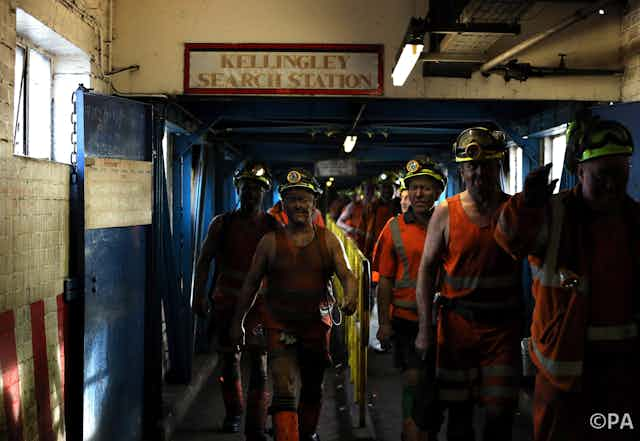The reign of King Coal is a story which is central to fully understanding modern Britain. Coal powered the industrial revolution, employed over a million miners at the industry’s height, shaped and sustained communities across the country, and has played a key role in the UK’s political economy. With the closure of Kellingley colliery, the country’s last deep mine, in December 2015, a defining chapter in British history comes to an end.
Although it had been mined in small quantities in Britain since Roman times, the story of coal as a major industry begins with the industrial revolution. From the 18th century onwards, demand for coal began to grow at an increasing rate. Several factors drove this, but its most important uses were as a fuel for steam-powered engines, in ironworks and metal smelting, and for domestic energy consumption in growing cities and towns. Then in the 19th century, coal grew to become the biggest industry in Britain in terms of workforce. It expanded from 109,000 workers in 1830 to nearly 1.1 million in 1913.
The early years of the 20th century proved to be the industry’s zenith, however. The period between World War I and II was one of crisis and catastrophic decline for coal. Its seemingly unassailable position was undermined by a series of economic factors – including the decision in 1925 by the Chancellor of the Exchequer, Winston Churchill, to return sterling to the gold standard. This had the inadvertent effect of making British coal too expensive in its important, but increasingly vulnerable, overseas markets.

As labour was the biggest cost in coal production, employers’ attempts to cut wages led to a series of bitter industrial relations disputes in the 1920s. The most well-known is the 1926 general strike, called by the Trades Union Congress in support of the miners. Although the general strike itself only lasted nine days, communities around the country’s coalfields held out for a further six months before finally conceding defeat.
Following the dark days of the 1920s and 1930s, the nationalisation of the coal industry in 1947 by the Labour government led by Clement Attlee seemed to many miners to represent the dawn of a new era – the attainment of a long-held aspiration. And, while it did lead to improvements within the industry, it was not the golden age that many hoped for – as the 1960s were to prove.
Decline and fall
The 1960s saw the first significant post-war programme of colliery closures, prompted by the increasing use of alternative energy sources – oil, gas and nuclear power. These closures disproportionately impacted upon the smaller and more geographically peripheral coalfields. Declining real wage levels and bitterness toward these closures led to strike action in 1972 and 1974.

The 1972 strike crippled the UK’s power supplies, forced a three-day week and a state of emergency. And, in response to the 1974 strike, Conservative Prime Minister Edward Heath called a snap election, which he subsequently lost to Labour. Both strikes were successful for the miners, leading to pay increases which put them among the highest paid of the working classes.
But, despite these victories, the strikes convinced senior figures within the Conservative Party – including newly-elected leader Margaret Thatcher – of the need to decisively confront and defeat the miners’ union, as the essential precursor to the denationalisation of the industry. Thatcher’s election in 1979 and re-election with an increased majority in 1983, made a major confrontation with the coal industry inevitable.

In March 1984, in response to the announcement of a further round of colliery closures, miners went on strike to defend their jobs. The majority stayed out for an entire year, enduring significant financial and personal privations in doing so. It was a landmark event, which provides the inspiration or backdrop to numerous films and TV shows including Billy Elliot and Pride.
Many commentators, both at the time and subsequently, emphasised the ideological battle that took place between the mineworkers’ union president, Arthur Scargill, and Margaret Thatcher. But, as recent studies of Scotland and south Wales show, striker solidarity was not dependent on Scargill. It was driven by the determination of miners and their families to protect their livelihoods and that of the entire coalfield community.
The miners’s eventual defeat in 1985, cleared the way for a major reduction in the size of the coal industry, as a prelude to its privatisation in 1995. In 1979, there were 235,000 miners in Britain; by early 1992 there were 32,000 – a figure which continued to dwindle thereafter.

For the communities in what were now rapidly becoming the former coalfields, the predominant experience was one of widespread unemployment and the problems associated with this. As a report published by Sheffield Hallam University in 2014 concluded, “the coalfields have significantly above-average levels of deprivation … The miners’ strike of 1984-85 may now be receding into history but the job losses that followed in its wake are still part of the everyday economic reality of most mining communities. The consequences are still all too visible in statistics on jobs, unemployment, benefits and health.”
From a historical perspective, the irony about the demise of deep mining is that the UK remains reliant on coal. Even in 2015, coal provided 20% of Britain’s total energy requirements. The major difference being, of course, that the vast majority is now imported from overseas, having been transported halfway around the world.
In terms of its rise and fall and the dramatic crises that it triggered, coal has been central to the 19th and 20th century history of Britain. Despite the industry’s zenith in the UK being a century ago now, its decline continues to cast a shadow over the former coalfield regions. With the closure of Kellingley, this iconic industry may have now finally disappeared – but its legacy is still very much with us.

